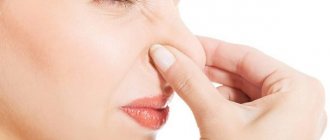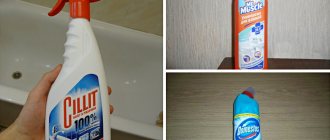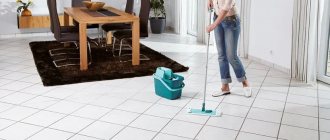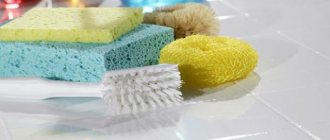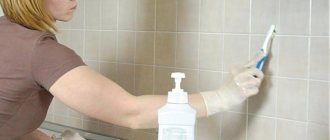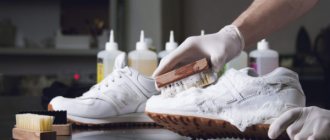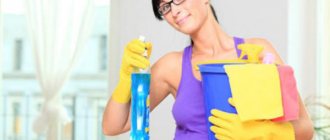Due to daily active use, tiles are constantly exposed to all kinds of contamination. The most pressing problems are limescale, fungus, yellowing and ordinary dirt. If water constantly gets on the tiles from a faulty tap or mixer, over time rust appears on the surface - the most difficult type of plaque to remove.
The tile seams require special attention: if they are poorly maintained, dirt gets clogged, and constantly high humidity contributes to the appearance of mold.
General recommendations
Means and methods for cleaning tiles are selected depending on the type of surface and type of contamination. Chlorine-containing products and laundry soap work well against yellowness and mold; fresh household dirt is easily washed off with soda and warm water; limescale and rust are dissolved by concentrated acids.
To clean bathroom tiles, use available products, as well as universal or professional household chemicals. Several recommendations will help you quickly complete the task and avoid common mistakes:
- Old rust or a layer of limescale can only be removed with special products based on strong acids. As a rule, good tiles are chemically resistant and are not damaged by aggressive substances. But acid can dissolve the grout in the seams, so it is advisable to stick masking tape on them. After removing the acidic composition and washing the surface, the protection can be removed.
- Aggressive detergents should not come into contact with delicate surfaces such as enamel, acrylic or chrome plated surfaces. During the procedure, you can put a plastic bag on the chrome faucet, and cover the enamel or acrylic bathtub with polyethylene or an old cloth.
- Chlorine can discolor colored tiles, so chlorine-containing compounds are used diluted.
- To clean tiles, do not use metal brushes or scrapers - they scratch the surface and allow dirt to get into areas of damage. This is especially true for glossy tiles.
- It is convenient to clean tiles in corners and other hard-to-reach areas with a flexible dish brush or a long-handled brush.
- To wash vertical cladding, it is preferable to use thick formulations: they do not flow over the surface, so they are convenient to apply and withstand the necessary time for effective action.
- Residues of detergents form stains on the tiles, so they must be thoroughly rinsed off with clean water.
- Using a steam cleaner helps you effortlessly clean and disinfect any surface. Microfiber pads absorb dirt and completely absorb moisture, making the surface shiny and leaving no streaks.
Note: Recently, melamine sponges have become popular for removing household stains. When wetted with water, they form a foam that cleans the surface without any cleaning agent. Fans of melamine sponges attest to their effectiveness, but there are also reviews of scratches left after cleaning delicate surfaces. In addition, the safety of melamine sponges for health has not yet been proven.
Melamine sponge.
Why does she stay dirty?
Many owners and housewives are faced with the following annoying problem - the tiles have just been thoroughly washed, but after drying they again take on an unpresentable appearance! There is only one reason for this - unfortunately, you don’t know how to wash tiles. The dirt left behind is due to the following:
- Dirty sponge, rag, napkin. You haven’t washed your “tool” well enough; grease has accumulated on it or pieces of dirt are stuck.
- Not completely rinsed off. In this case, cloudy stains will remain on the tiles. You should change the water several times to thoroughly clean the tiles from the cleaning powder or gel.
- Hard water. Even if you have washed the tiles clean, you should not expect a satisfactory effect with tap water, which contains a lot of salts.
- Uncleaned dirt. This is especially true for greasy stains - not all products can wash them off, but they can be smeared with ease!
- Dirty water. Maybe you were too lazy to change the water when cleaning after it became cloudy? Then yes, in this case the tiles will not look perfect when finished.
Take care to protect your hands
Advice! To make the tiles look like new after cleaning, it is not enough just to use a “super-duper” product and know how to clean the tiles. The correct algorithm of actions is also important.
A lot of sponges and brushes will come in handy
Available means
For minor fresh stains, you can use proven folk recipes that are always available at home.
Laundry soap
Laundry soap removes yellowness and whitens tiles well. It is enough to rub a brush or sponge with a bar of soap and treat the surface. The product gives a thick foam and stays on the surface for a long time. Leave the applied soap for 30-40 minutes, rinse with water and wipe the tiles dry.
Note: Whitening laundry soap is well suited for white tiles: it makes the surface snow-white and shiny. But on colored tiles it should be used with caution: in rare cases it can reduce the intensity of the color or make it uneven.
Vinegar
Acetic acid is successfully used to clean limescale from cladding. Vinegar is applied from a spray bottle or sponge. As a rule, the surface must be rubbed. If the plaque is relatively fresh, vinegar will remove it.
In combination with salt, vinegar is effective against rusty deposits. A napkin or rag is well moistened with vinegar, dipped in fine salt and carefully wiped off the rusty stains. An aqueous solution of vinegar is suitable for everyday tile care: the ingredients are mixed in equal parts and poured into a container with a spray bottle. The product can be sprayed on wall tiles and tile joints daily.
Baking or soda ash
Baking soda can remove grease, fresh rust, mold, dirt and water stone. Before treatment, the surface of the tile is moistened with water. Pour soda onto a wet sponge and rub the stained areas. The product is left for 15 – 30 minutes. During this time, the plaque usually softens and is easily wiped off with the hard side of a dish sponge or brush.
Note: For cleaning glossy tiles, soda ash is preferable: it dissolves better and has virtually no abrasive particles. A good cleaning effect is achieved due to a more alkaline reaction compared to baking soda. The advantage of soda ash is that when washed off, this product does not leave streaks. Therefore, when washing dark, matte or colored tiles, it is better to choose soda ash.
Hydrogen peroxide
Pharmacy 3% peroxide whitens yellowed seams, colored stains or traces of hair dye. On porous tiles, stains will have to be treated several times. The peroxide is gradually absorbed into the pores and after 3–4 applications, the stains usually noticeably lighten or disappear.
Ammonia
Ammonia is often included in liquids for washing glass, mirrors and other glossy surfaces. By itself, it does not remove stains well, but it is added to prevent streaks after washing. An aqueous solution of ammonia (2 tablespoons per 1 liter of water) is suitable for finishing the tiles after basic cleaning.
Lemon acid
Lemon or citric acid softens limescale and gives a slight whitening effect. Sprinkle the powder onto a sponge and wipe the tiles. In this way, you can wash the tiles from fresh deposits in 2-3 minutes.
Note: Citric acid powder may scratch the glaze of glossy tiles, so it must first be dissolved in a little water or replaced with lemon juice. It is not recommended to apply the product to seams - citric acid partially dissolves the grout, and when the product is washed off, white stains form on the tiles.
Tea tree oil
Tea tree essential oil is known for its antibacterial and antifungal properties. It can be used pure or added to household and industrial cleaning products. Regular use of tea tree oil is a good prevention of mold.
What to wash with
Ceramic tiles have different surfaces, and how cleaning will be carried out depends on this, and not just on the nature of the dirt.
Old stains can be removed with standard solvents containing acetone, gasoline, etc. But to do this, you need to make sure that they do not damage the floor covering. To do this, carry out the test in an inconspicuous place.
Tiles with a matte surface require special care when cleaning. Even if it looks smooth, it is actually rough. And dirt particles love to linger in uneven surfaces. When washing such a floor, you should be especially careful to remove debris and dust, and not to use powders or other abrasives. Otherwise, cloudiness will appear that will be impossible to remove.
Household chemicals
There is no need to purchase special products to wash tiles. Regular dishwashing detergent works very well for removing greasy stains. It is enough to apply it for a few minutes. But rubbing with the hard side of the sponge is dangerous. Microcracks may remain, which will become larger each time.
Severe stains are perfectly removed by the gel for washing sinks and toilets. It also needs to be applied to the surface for a short time and then washed off with plenty of water.
Ketchup, coffee, tea or blood stains can be removed with baking soda. You need to mix it with water to a paste and apply it to the stain for 3-5 minutes.
Advice!
Remove the product applied to the stain with a regular damp cloth.
If the tile is covered with glaze, you need to purchase a special product containing mastic for it. Then, after dry cleaning, you just need to remove the stains and wash the floors, dissolving it in accordance with the instructions. Mastic will not only add shine, but will also create a protective film that will make the next wash easier.
Of all the household chemicals intended for cleaning tiles, housewives really like:
- silit. Excellent stain removal and a budget option;
- Amway. Expensive but very effective;
- Mr. Propper. Can be used both to remove stains and to clean the entire floor. In the first option, it must be applied to the contaminated area, and in the second, diluted with water in accordance with the instructions.
Take note!
The melamine sponge perfectly cleans floor tiles and keeps the surface clean for a long time.
Folk remedies
Using improvised cleaning products allows you to achieve results no worse, and sometimes better, than household chemicals.
Most often this is:
- ammonia. Excellently removes dirt and adds shine to tiles for a long time. Can be used after preliminary removal of debris and wiping. Dissolve a spoonful of ammonia in a bucket of lukewarm water, moisten a rag and thoroughly wipe the floors;
- vinegar. Also used after preliminary cleaning. To prepare the solution, you need to dilute 100 ml of vinegar or 10 ml of vinegar essence in a bucket of water;
- chalk with paper. Suitable for glossy tiles only. You need to prepare a solution of rich white color, wipe the floors, and then rub them with paper to add shine;
- lemon acid. An excellent option for express cleaning. Needs sweeping. Pour a solution of a pinch of lemon and a liter of water into a spray bottle. Spray on the floor and wipe with a dry cloth or mop.
Important!
When working with the listed products, be sure to use protective gloves and preferably a mask.
Chemicals
To wash tiles, you can use popular industrial products for ceramic and earthenware products. Professional products are presented as universal options for all types of tiles, as well as special compositions for glossy or structured coatings. To effectively clean tiles, the chemical industry offers the following products:
- Domestos (Unilever) Thick antibacterial gel based on sodium hypochlorite removes mold, limescale and yellow stains. For tiles, use diluted: 4 caps (60 ml) per 5 liters of water, apply for 5 minutes.
- Cillit Bang “Anti-raid” (Russia). Acidic product for effective removal of all types of plaque. Use with caution on glossy tiles.
- Kraft Zwerg Tile Cleaner (Germany). An effective emulsion created using nanotechnology. In addition to cleaning the tiles, it restores its shine and color and creates a protective film with an antistatic effect.
Kraft Zwerg tile cleaner. - Luxus Professional “Clean Bath” (Russia). Environmentally friendly antibacterial spray for universal use. Adds shine, does not damage surfaces and is easily washed off with water without leaving streaks. Removes mold, grease, lime deposits.
- Mellerud for tiles and stones (Germany). Phosphoric acid based product for quickly dissolving limescale.
Mellerud for tiles and stones. - HG for cleaning glossy tiles (Netherlands). Professional cleaner for glossy ceramic surfaces, leaves no streaks.
- Kiilto Clean for tiles (Finland). A professional product based on oxalic acid to remove rust, limescale and cement residues from tiles. Does not damage glazed surfaces.
Professional gel Kiilto Clean against rust and plaque.
Best deals on tile cleaners:
How do divorces occur?
Even the most thorough cleaning of ceramic tiles can result in its surface being covered with gray stains. Why is this happening?
1. Severe clogging, dirt not completely washed off. In this case, small particles of dust are smeared with a rag on the surface of the product, and cleaning them the first time turns out to be very problematic. 2. Dirty water is used. 3. Use hard water with a high salt content. 4. After washing the tiles with water, particles of detergent remain on its surface, resulting in white stains. 5. A dirty rag is used. 6. A limescale deposit remains on the surface, which subsequently turns into white stains.
To cope with the above problems, it is necessary to select products in an acidic environment for cleaning tiles. They perfectly remove dirt, kill bacteria on the tile surface and give the material a spectacular glossy shine! All products recommended for cleaning tiles can be divided into improvised (folk) and household (chemical).
Features of washing different types of tiles
Glossy tiles
Limescale deposits, soap stains and fingerprints are very noticeable on glossy tiles. You can remove dirt and return the tiles to their original shine using window cleaning liquid or a special detergent. To prevent plaque, the glossy surface can be coated with a water-repellent impregnation. It is advisable to apply such a solution as soon as possible after laying the tiles - the effectiveness of the product will be higher if the coating has not yet had time to absorb moisture. A good product for cleaning glossy tiles:
Matte tile
The matte surface often leaves stains after washing and traces of dried water. This makes the tile look untidy. Matte tiles will look spotlessly clean if you apply one of the following recommendations:
- after washing, wipe the surface dry with a moisture-absorbing microfiber or bamboo cloth;
- add vinegar to the washing water (⅓ glass of vinegar per 5 liters of water);
- wash the floor with a solution of soda ash (3 tablespoons per 5 liters of water);
- after washing, rub the tiles with glycerin or a special tile polish;
- use a steam cleaner.
Relief tiles
Three-dimensional designs and patterns make washing relief tiles labor-intensive, especially in the case of old stains. Therefore, such tiles require careful and regular maintenance.
Foams and emulsions are best suited for cleaning structural tiles from dirt and stubborn deposits: such products penetrate well into pores and other irregularities.
To remove stubborn plaque and stubborn dirt, brushes with soft but thick bristles are preferred.
On glossy structural tiles, it is advisable to use polishes or detergents with the effect of a protective film.
Floor tiles
Floor tiles are most often made matte, since this particular coating does not become slippery even when water gets on it. Therefore, for washing floor tiles in the bathroom, the same techniques are relevant as for matte wall tiles. But in addition, you should take into account that floor tiles become more dirty than wall tiles.
To maintain cleanliness, the tiled floor in the bathroom should be swept and wiped daily with a clean mop soaked in a vinegar solution. Otherwise, soap splashes, toothpaste, water and cosmetics that fall on the floor will form stains that will attract dust and small debris. Once dry, it will be more difficult to remove such stains.
A special polish will help reduce the maintenance of floor tiles as much as possible. Floor tile polish:
Causes of pollution
You need to clean stains based on the cause of their occurrence. The most common:
- hard water. It leaves behind divorces;
- A cleanser that is not completely rinsed off. This is why many people make do with plain water;
- fat. First you need to remove the stain, and then wash the entire floor so as not to leave greasy marks all over the surface;
- dirty rag. You need to rinse it regularly and very thoroughly;
- dirty water. You need to change it regularly, otherwise, when the floors dry, dirty streaks will remain on them and you will have to completely wash everything.
How to clean the seams between tiles
Tile seams are very vulnerable areas on the cladding. Their porous surface allows moisture to pass through well and quickly becomes dirty. It is in the seams that mold often settles and a yellow coating appears. The poor resistance of the grout to potent substances further complicates its maintenance.
You can clean the seams between the tiles with an old toothbrush using the safe folk methods listed above.
To treat seams, you can prepare a homemade bleaching paste based on hydrogen peroxide. To do this, combine ¼ cup of peroxide, ½ cup of soda and 1 tbsp. l. liquid soap. The mixture can be stored in a closed glass or plastic container.
To combat mold, chlorine-based products are used (Belizna, Domestos).
It is possible to use household chemicals, but frequent use of acidic compounds helps to gradually wash out the grout mixture from the joints.
A steam cleaner gives a good result: hot steam penetrates deep into the pores and effectively cleans the seams even without the use of detergents.
Note: It is not advisable to frequently wash tile joints with dishwashing detergents or washing gels (with the exception of antibacterial compounds). The remaining product gets clogged into the pores of the grout and, combined with high humidity, creates a breeding ground for mold.
We recommend: 9 ways to clean tile grout.
How to wash tiles to make them shine?
This type of flooring can be given shine using special household chemicals containing mastic, as well as using a solution of citric acid, ammonia or vinegar. But it should be remembered that you should not abuse the use of such funds. They negatively affect the condition of the tile joints.
An alcohol solution is safer in this regard. For 4 liters of warm water, take 125 ml of alcohol and, moistening a rag in the resulting mixture, thoroughly rub the clean floor.
Methods for restoring grout
If the condition of the grout is generally satisfactory, but the seams have lost their original appearance, they can be updated using the following methods:
- Apply a bleaching pencil or seam marker. Often these pencils contain antifungal additives and can temporarily refresh the grout and protect it from mold.
- Apply waterproof paint. The method is short-lived, but the grout will look neat for several months.
- Partial renovation of grout with replacement of the top layer.
In case of deeply ingrained dirt and severe fungal infection, the old grout is completely removed and replaced with a new mixture. The new composition must contain biocidal additives that protect the seams from mold damage.
We recommend: 7 ways to update tile joints.
How can I restore after repair?
Before carrying out repair work, the floor surface must be protected as much as possible from all possible contamination. But you will still have to do a more thorough cleaning than usual afterwards.
You can remove silicone sealant or adhesive from tiles using ammonia solutions. They are sold ready-made in construction stores. You just need to dampen a piece of rag and wipe the stain. Some household chemicals designed to remove complex stains are also suitable, especially if they contain a solvent.
Traces of primer or cement are removed with a new solution. It's surprising, but it really works. The old stain dissolves and it becomes very easy to wipe it off with a regular rag.
The grout can be washed with plain water. The main thing is not to delay cleaning. Until the top layer begins to lighten, the grout will be as easy to remove as whitewash.
Useful tips and prevention
Tiling is very durable, but in order for it to maintain its attractive appearance and perform its functions, the surface must be properly cared for:
- The seams between the tiles can be treated with moisture-proof impregnation, which significantly extends the service life of the grout and prevents dirt from penetrating inside.
Protective impregnation Atlas Delfin for tiles and joints. - Before applying polish, clean the tiles thoroughly, trying not to leave streaks: any dirt will be visible under the protective coating. They can be removed only after removing the polish layer using special means.
- During repair work, try to prevent glue or working solution from getting on the cladding, and if this does happen, immediately wipe off the dirt with a wet rag.
- With increased hardness of tap water, it is not advisable to leave the tiles wet for a long time: drops that dry on their own leave marks. At night, it is better to wipe the lining with moisture-absorbing cellulose or microfiber cloths.
- Constant dampness in the bathroom contributes to the appearance of mold, especially at the seams between the tiles. Therefore, good air exchange and ventilation are of fundamental importance.
- It is advisable to clean the tiles once a week, and the seams once every two weeks. Regular washing of tiles is the only way to avoid persistent plaque and ingrained dirt.
Advice! If you need bathroom renovation specialists, there is a very convenient service for selecting specialists from PROFI.RU. Just fill out the order details, the experts will respond and you can choose who to collaborate with. Each specialist in the system has a rating, reviews and examples of work, which will help with the choice. Looks like a mini tender. Placing an application is FREE and does not oblige you to anything. Works in almost all cities of Russia.
If you are a master, follow this link, register in the system and be able to accept orders.
How to clean wooden floors?
If the floor is painted, then it is enough to wash it with water with the addition of ammonia, it will add shine to the floor. To achieve the result, a couple of tablespoons per bucket of water is enough. By the way, the smell will disappear almost immediately, but for insects like mosquitoes it will last for a very long time, which will also allow you to save on repellents.
Unpainted wooden floors are best washed, unlike other surfaces, with water containing alkaline additives. You can dissolve a little washing powder in water, or even better and more environmentally friendly than laundry soap or soda.
Top 3 special compositions for washing
The range of household chemicals includes a wide range of special products for cleaning the bathroom, and tiles in particular. Such preparations allow you to thoroughly clean the surface, eliminating even stubborn stains.
Cillit Bang “Anti-raid”
An acid-containing cleaning product effectively removes:
- rust,
- soap stains,
- lime.
The product is applied to the stained surface by spraying or sponge. After 5 minutes, it is removed and the tile itself is washed with plenty of water.
The average price is 270 rubles.
Unicum spray
The product allows you to remove limescale deposits from tiles and properly process seams . Unicum is antibacterial and removes odors well.
Contains chlorine and surfactants. Treatment with a spray is simple, the drug is well distributed. Manufacturer – Israel.
Price – about 250 rubles per bottle.
Mellerud
Concentrated detergent is available in liquid form. Cleans Mellerud carefully and effectively without harming surfaces .
The product is suitable for ceramics and natural stone that does not contain limestone, since the composition contains acids. Effectively removes rust and lime. Manufacturer – Germany.
The liquid is applied to the moistened surface either diluted (1:5) or pure. For best results, the product must be rubbed with a brush. Wash off with plenty of water.
The average price is about 550 rubles.
Which mop is best for cleaning tiled floors?
A clearing tool with a sponge attachment is ideal for cleaning tiled floors. This mop is the best for cleaning tiled floors, as it does not leave stains or streaks and perfectly removes pet hair. A rope mop has proven itself to be quite good when caring for tiled floors.
Interesting materials:
How to remove yellow sweat stains from colored clothes? How to remove yellow stains from a collar? How to remove greasy wax stains from clothes? How to remove a grease stain from a T-shirt? How to remove grease stains from water-based paint? How to remove chewing gum from a skirt? How to weather a new sofa? How to open BIOS on ASUS? How to call the Boot Menu when booting? How to open the boot menu on Lenovo?
Specialized detergents for ceramic tiles
Wash with special means
In order to carry out high-quality cleaning of shiny ceramic surfaces, you can find a lot of household cleaning chemicals on store shelves.
We suggest you familiarize yourself with White mold in the cellar, similar to cotton wool: why it is dangerous, how to get rid of it, photo
Each composition has its own characteristics associated with the removal of one type of contamination; there are also universal means for washing tiles. It is worth focusing on popular, proven means. So, how to clean the tiles on the floor from stubborn dirt:
- Silit. Will wash away dirt well from ceramic surfaces in any room.
- "Selena". It is inexpensive and is used to clean floors without streaks.
- Amway. This “drug” is already more expensive, but its effectiveness in combating stains and other stains is high.
- Mister proper. A universal composition for cleaning floors from dirt. Can be used on porcelain stoneware.
An innovation has appeared on the market with which to wash tiles - a melamine sponge, which does an excellent job of removing stubborn stains. Ink, pencil, paint and other black “armies” can be easily cleaned with a universal sponge.
It is worth noting that you should not use powdered floor cleaners, as they contain abrasive particles that can damage the ceramic surfaces.
Cleaning dirty, greasy tile floors in the kitchen: remedies, tips
The kitchen is a room that gets dirty very often. The reason for this is the constant cooking process (spilled liquids, debris falling on the floor, boiling and shooting oil, soot and scale). As a result, the tiles on the walls and floor are heavily covered with a layer of grease.
How to delete:
- You should use a product that contains alcohol or acid. They eat away fat, making it more “liquid,” which makes it easier to remove from surfaces.
- Special chemicals or alcohol will help you remove greasy deposits.
- After such cleaning, the surface can be washed with soap or all-purpose solution.
- To make the tiles shiny, they should be rubbed with glass cleaner.
How to clean tiles in the kitchen?
Basic principles of floor cleaning
How many times should the floors be washed per week is probably of interest to many housewives. It is recommended to wash the floors once or twice a week, removing any remaining dirt and dust.
It is worth paying attention to carpets and the surfaces underneath them. If there are small children or pets in the house, it is ideal to wash the floors every day or every other day.
What to do if cleaning is very exhausting, and the apartment is so large that it is absolutely impossible to wash the floors every day? Apply the following tips:
- For floors with coatings that are easy to clean, use disposable wet wipes. This will significantly save your energy and time, there will be no need to drag the mop across the floor and rinse it every other time, and besides, cleaning will be more effective, due to the fact that the rag will not be washed so well that there will not be a speck of dust left on it.
- First you need to wash off the dust from tables, window sills, and various furniture in the apartment, because as a rule, dust begins to accumulate there and then flies to the floor.
- Before washing the floors, you need to vacuum the entire apartment, not forgetting about hard-to-reach places and corners, because they can fly dust into the center of the apartment.
- Cleaning skirting boards is as important as the floors themselves: they leave a lot of dust on them.
- When you don’t have time to wash the floors every day, there is the following solution to this problem: wash those places in the apartment that get dirty faster. This is a corridor, a kitchen, a balcony.
- Small dirt that may accumulate during the day must be removed immediately, rather than waiting for wet cleaning to begin.
Cleaning with a mop
First you need to vacuum (sweep with a broom) the floor, the further cleanliness of the floor depends on how well this is done. Next, we lift all the furniture that can be lifted (chairs, computer chairs, etc.) and be sure to wipe off the dust from the legs of the raised furniture. Furniture that cannot be lifted must be moved away so that it can be vacuumed and the floor washed to remove dust. Don’t forget to also wipe the dust off the baseboards. Well, actually, let’s start wet cleaning. To do this, we need a mop, detergent and a brush to remove heavily soiled areas.
We begin to wash the floor in the areas from which we moved the furniture (bed, sofas, chests of drawers, etc.). After complete drying, we put the furniture back in place and wash the rest of the room we walked through. After finishing cleaning one room, we need to change the water and thoroughly wash the mop, after which we can move on to the next room.
Cleaning tile joints
Several recommendations for washing interstitial seams:
- The simplest method of washing seams is to treat them with a soda solution. To do this, you need to dilute baking soda with water until it becomes pasty. Easy to apply with an old toothbrush. Leave for 30 minutes. As a preventative measure, carry out this manipulation every time you clean your apartment.
- If the fungus has already begun to appear, you need to add vinegar to the soda mixture. This product will help fight mold and restore the tiles to their former attractiveness;
- If you want to return the seams to their former whiteness, you can use bleach. The product is applied and left for several minutes.
- Peroxide has proven itself to be excellent in the fight against fungal growths. You need to apply it on a cotton pad and go over all the seams. You can also mix peroxide with detergent. Apply to seams and leave for 60 minutes. After this, rinse the floor with clean water.
- Copper sulfate is an excellent method of fighting fungus. The product is diluted with water and poured into a spray bottle. The tile must be treated with a soap solution, and then apply liquid with copper sulfate.
- Borax is a suitable preparation for combating mold. There is no need to rinse off because it acts as a protective barrier for the flooring.
- Essential oils work well against fungus. Such as grapefruit and tea. The liquid is applied in a diluted state - 1 to 10 and washed off with water.
How to use tile products correctly
Special products for cleaning tiles, first of all, strong chemicals. Therefore, it cannot be used thoughtlessly and carelessly. Otherwise, you can damage both yourself and the coating. Here are some tips that will help you avoid damaging the tiles during the cleaning process or make your work easier:
- When working with any means, we recommend using gloves, a respirator and safety glasses to avoid injuries and unpleasant consequences.
- Do not use abrasive powders on tiles. Especially for glossy ones. After several such cleanings, the surface will become unusable and begin to deteriorate. And, accordingly, it gets more dirty and more difficult to clean.
- Try not to use acidic products if there is grout in the tile joints. They can destroy the composition, and as a result the grout will look disgusting. There is another solution - to treat the seams with epoxy paint or any other compound that can protect the composition from destruction by acids.
- Do not use acidic tile cleaners if your tiles contain any form of lime - the surface will begin to deteriorate under the influence of acid.
- Alkaline chemicals are less effective, but they are gentler on tiles. But it is important that the composition does not contain abrasive particles - for example, insoluble soda or sand.
- Don't forget to test the new product on an inconspicuous area of the tile floor. This will help you find out exactly how the tile will react to the composition.
By following these tips, you can easily keep your tiles safe and sound. And don't harm yourself by inhaling the fumes or irritating your hand skin.
No. 2. dishwashing detergent or soap
Light stains can be washed off with regular dishwashing detergent. It is enough to dissolve a small amount of it in warm water until foam forms. The resulting solution is applied with a sponge to the contaminated tiles, left for 10-20 minutes, and then thoroughly washed off with plain water.
Instead of detergent, you can use regular soap (laundry soap is not recommended). To make the dissolution process faster, you can rub the bar soap into warm water. Next, the washing process is similar to that when using dishwashing detergent.
